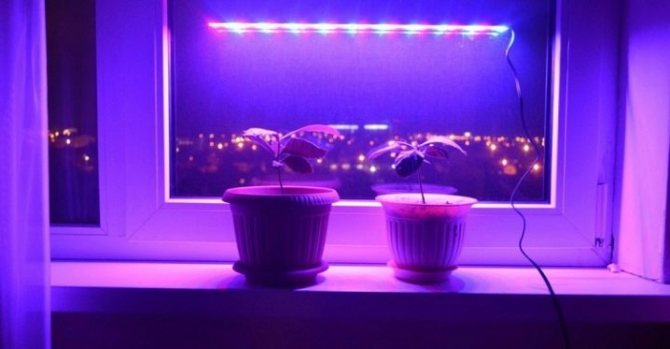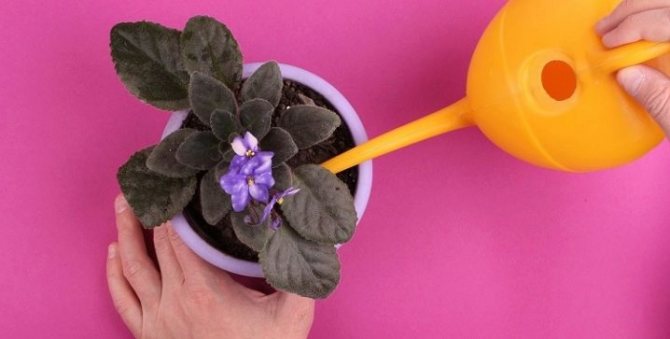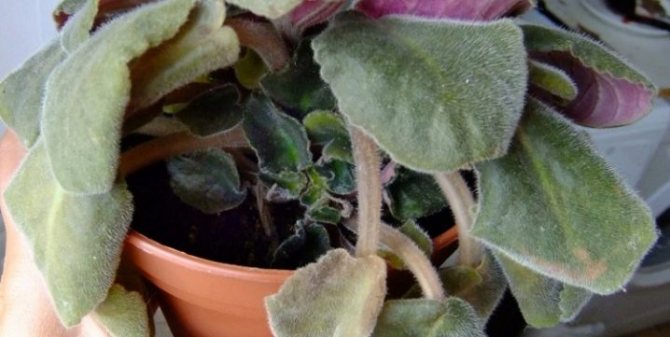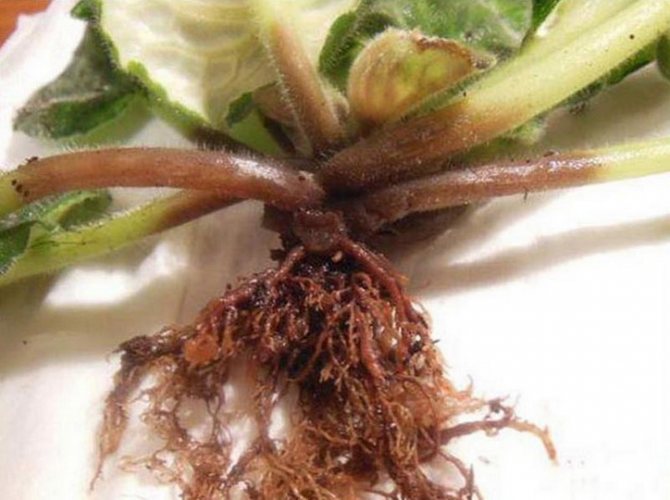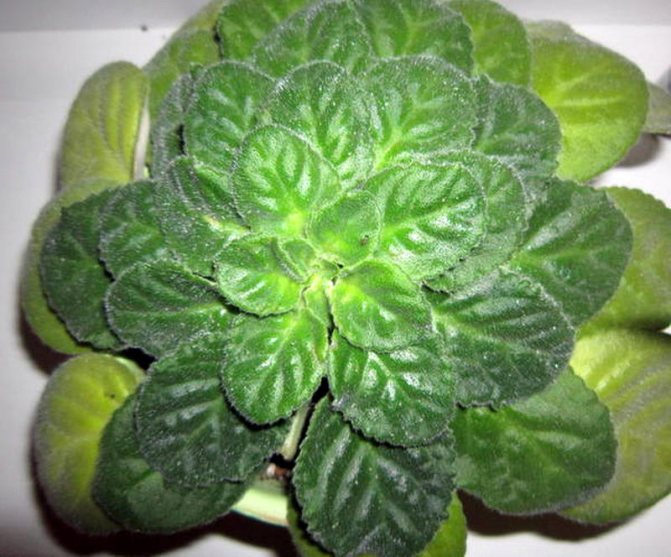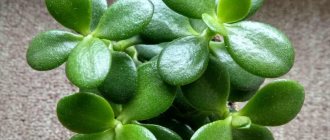Indoor violet (Saintpaulia) is a fragile, charming plant whose flowers decorate the house almost all year round... To do this, she needs to be cared for properly.
One of the symptoms of a containment breach leaf lethargy is... A diagnosis and proper treatment will ensure the health and long lasting flowering of the violet.
Why does the violet disappear at home?
When growing Saintpaulia, everyone can have mistakes. Sometimes there may be problems that do not depend on the observance of all the rules of care, the place and conditions for growing Saintpaulia.
If a violet disappears, the reasons for this may be the following:
- hypothermia or temperature drops;
- waterlogging or lack of moisture;
- sunburn;
- rot;
- parasites;
- bad soil;
- infections.
Each problem has a treatment, if you do not have time in time, you have to reanimate the flower.
Video "If you poured a violet"
In this video, you will learn what to do if you accidentally flooded a violet.
If it's too late to take treatment it remains only to reanimate the dying violet... How to reanimate violets at home depends on the problem due to which the plant dies, on the experience of the grower and the materials available.
- how to save a violet if it is flooded;
- what to do if the violet is burnt in the sun;
- how to save a violet that has lost its turgor and in other difficult situations.
The reasons for the wilting and death of Saintpaulia in the apartment
The main factors leading to the death of a flower consist of mistakes made in care, diagnosis or their treatment... If we talk about mistakes that can be made in room conditions, the following three are the main ones.
Conditions of detention
Improper care - This is the most common factor leading to disease and death of violets.
Some growers are frivolous about the choice of soil and plant their saintpaulias in unsuitable substrate. The consequence of such a decision can be root disease, and when the problem is started, rotting begins.
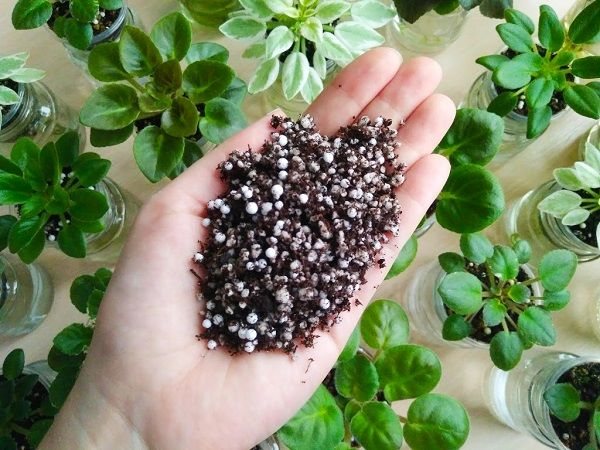
It is very important to choose the right soil for the violets.
Hypothermia and freezing
The most dangerous periods for the occurrence of such a problem are spring and autumn, under certain conditions this can happen in winter:
- Spring: when the heating is turned off, the temperature in the house can drop sharply, the pots on the windowsills can freeze from the window, especially if the leaves touch it;
- even if the heating has been turned off for a long time and the temperature is suitable, there is a risk of spring temperature drops if a cold snap leads to problems.
Even a short-term drop in temperature can harm the plant., especially if it is accompanied by an increase in humidity. In such conditions, fungus or rot can form and develop rapidly.
Important! Draft, especially in cold weather, can lead to severe hypothermia, and is the onset of flower disease.
Solar influence
Violets and sunlight are one of the stumbling blocks for budding florists. On one side of the violet a lot of bright lighting is neededand on the other they don't like direct sunlight, as they quickly get burned and this leads to the death of the plant.
Placing flowerpots on southern windows should be avoided, and if there are no other options, then they need to be shaded.
There is also a risk that Saintpaulia will get sunburn even on the west or east windows. This is possible in summer, when the sun is active, or in winter, if the windows on the first floor, and there is a lot of snow outside.
How to avoid a flood of flowers
What you can do to avoid flooding plants, even if they are watered by another person in your absence:
1. The size of the pot should correspond to the variety and the size of the rosette. The diameter of the rosette should be 2.5-3 times the diameter of the pot (see photo). Pots with a diameter of more than 9-10 cm - not suitable for violets, except for trailer varieties,
2. In pots of different materials, and different probability of soil acidification. Ceramic pots are more likely to dry out. Collectors don't use them. Pots made of thick plastic do not deform when you take it in your hands, the soil does not peel off from the walls, on the contrary, it sticks to the walls. In such a pot, the greatest danger of the plant flooding.
A container made of thin and flexible plastic deforms with slight compression, an air gap forms between the wall and the earthen lump, the soil dries out faster, the roots breathe better. Such a pot is more likely to dry out. When watering, water often simply flows down the sides of the pot, without wetting the ground. This is indicated by two factors: simultaneously with watering, water appears in the pan, and the pot remains light in weight, as before watering.
3. Virtually never sour soil containing a sufficient amount of vermiculite. In all purchased soils, its content is insufficient, or not at all. Purchased soil of a very dark, almost black color is made on the basis of lowland peat, which sour very quickly, it is better not to use such soils at all.
It is necessary to buy soil containing reddish-brown, coarse-fibrous high-moor peat. Thus, vermiculite or perlite should be added to a suitable purchased soil or garden soil, per 5 liters of soil 0.5-0.7 liters of vermiculite. It absorbs moisture well, and then gradually releases it. It is advisable to add there a full handful of cut (up to 0.5 cm) sphagnum moss and 0.5 cups of small pieces of charcoal as an antibacterial component.
4. Drainage should be made at the bottom of the pot, preferably from medium expanded clay.
5. The sump should be wide and not deep, then the excess water will spread out in a wide, but not deep layer, not exceeding the drainage layer. Excess water is drained 15-30 minutes after watering, but in such a pan, even if the water is not removed, it evaporates quickly without harming the plant, and the humidity around it rises.
6. Often soil acidification is associated with hypothermia of the earthen coma. In the cold, dark season, even in a warm room on the windowsill, the temperature can be 10 ° C lower than in the room.
Abundant watering in such conditions is very dangerous. The air contained in the pores of the soil is a heat insulator, and displacing the air, the water quickly cools on the windowsill, and the roots are supercooled.
Diseases in such conditions have a lightning-fast course. You can isolate from a cold window sill with the help of polystyrene and other similar materials. And you can water in cold weather only with warm water (it should be lukewarm to the touch).
7. Watering is strictly metered.To do this, it is convenient to use plastic bottles, into the caps of which the juice tube is tightly inserted. The water flows out in a thin stream, you won't accidentally splash too much.
Water must be poured before it appears in a small amount in the pan. Before watering, it is a good idea to check each pot by weight: heavy - like those that have just been watered, and if the top layer is still wet from the previous watering. Such a plant must be taken under control. If the soil has not dried out even after a day, it means that there has been an overflow.
8. Overdrying of the plant threatens overflow, no matter how paradoxical it sounds. With a strong overdrying, small young roots die off (they just dry out). With abundant watering, the plant, due to the loss of roots, cannot absorb all the moisture, and the soil sour and begins to rot.
When dry, the plant is watered gradually, little by little, but more often. If, during drying, all the leaves, both old and young, have withered, then all the roots have also died, it is no longer possible to save the plant.
How to save and reanimate a violet?
Plant resuscitation can vary greatly depending on the cause. If a violet disappears through factors associated with indoor conditions, then it is quite simple to reanimate them, but it is important to follow all the rules.
Hypothermia and freezing
What to do if the violet is frozen depends on the area affected by the cold:
- leaves and stem (with growth point damage): remove all diseased leaves. If the saintpaulia is frozen from above, the top with the growing point is cut off to deciduous rows that have not suffered, or have not suffered much. Sections are treated with activated carbon;
- the flowerpot is moved to more comfortable conditions;
- caring for a resuscitator does not differ from caring for healthy plants, but watering must be slightly reduced;


This is what frozen leaves look like. - to speed up the resuscitation process, you can water the flower with the addition of dressings every week;
- after a while, stepchildren form on the stem, near the leaf axils;
- if possible, the violet deepen, for contact between the ground and the stepsons. Under such conditions, they can form roots prior to separation from the mother plant;
- when the children grow up to a size that allows them to be rooted separately, they are separated;
- follow-up care is consistent with the care of young violets.
- the frozen violet is taken out of the pot, the roots are examined, the spoiled ones are cut off;
Advice! The upper part of the violet can be rooted in sphagnum moss, hydrogel and peat. You can also use Kornevin to speed up the process.
Sunburn
With the harmful effects of sunlight, only the upper part of the violet suffers. Ways to reanimate a room violet depends on the severity of the damage:
- A few leaves burned in the sun can be just delete;
- If the core is affected, the violet must be completely reanimated.: Cut off the entire affected top, be sure to leave a few leaves, or their healthy parts. All cuts are sprinkled with charcoal;
- Care corresponds to the usual, except for the amount of moisture, it is reduced;
- After a while, stepchildren appear;
- After growing up, the children are planted in separate containers, having previously rooted.
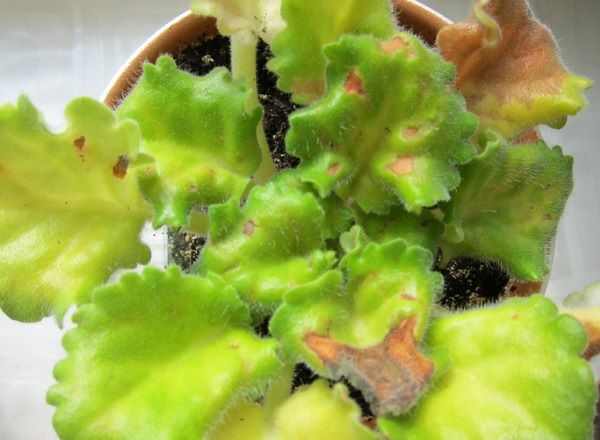

Sunburn on the leaves.
Improper watering
Moisture-loving Saintpaulias react very seriously to improper watering. If there is a lack of moisture or overflow of violets - what to do:
- excess moisture - if there is always a lot of water, the roots rot and the violet dies... What to do if the violet is flooded with water: the flooded violet is taken out of the pot, all damaged roots are cut off;
- if there are enough roots, the plant is moved to an appropriately sized pot. A badly damaged violet is cut off at the bottom;
- then rooting is carried out in the most convenient way: in the ground;
- in water;
- in moss;
- in a hydrogel;
- in peat.
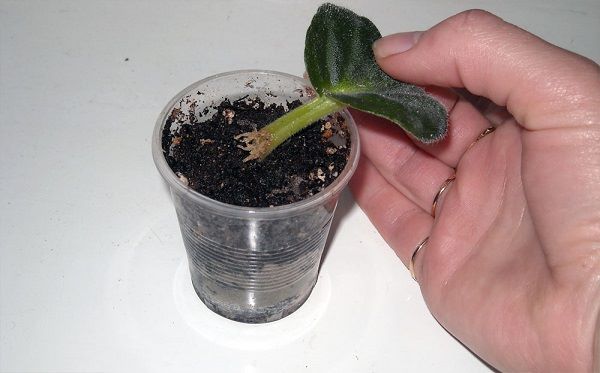

Violet stalk with roots.
- lack of watering - overdried violet loses turgor, then the leaves dry out and soon the roots suffer, usually irreversible damage to the core occurs last... How to revive a violet at home in this case: if only the leaves are affected, watering is normalized and everything returns to normal;
- in case of damage to the root system, transplanting and putting in order the irrigation system is enough to improve the condition;
- in a neglected state for resuscitation, it is necessary to cut off the living apex and root it. After rooting, the plant is transplanted to a permanent place.
Bad ground
Improperly selected or old soil can lead to decay of the root system.
In this case you can save a plant from death only by re-rooting it:
- The top is cut off;
- Remove the lower leaves;
- The stem is placed in water (you can use sphagnum moss or hydrogel);
- After the appearance of roots, from 1.5 cm in size, the top is planted in the ground (you can immediately root it in the ground, but this does not allow you to observe and control the process;
- Potting is done more as needed. Plant care should be consistent with juvenile care.
Advice! Healthy leaves obtained by preparing the tops for rooting can be used for propagation.
Pests
Parasites, as a rule, live on the green part of the plant and in the root zone - in these places they receive a sufficient amount of moisture, so they can intensively develop and multiply. The first sign of damage is wilting of the leaves, but if you do not take urgent measures, then in a short time the flower dies, so urgent resuscitation is needed. If you notice that the leaves of your violets have grown, sank, become loose and darkened, then you should take a closer look at the leaf plates. Usually pests are clearly visible even with the naked eye, and even if the insects themselves are invisible, the damage they caused is striking - such leaves are usually covered with eaten holes.
Most often, the violet is attacked by aphids, spider mites, scale insects and root worms. Aphids are easiest to notice - they are quite impressive in size and visually resemble small midges. But it is not so easy to notice ticks, they affect both leaves and roots, the violet becomes lowered, and small holes form on the leaves... The scabbard leaves a sticky coating on the leaf plate, in addition, many dark dots can be noted on the reverse side. To treat a flower, it is necessary to wash off the insects with a concentrated solution of laundry soap, then transplant the flower into a new soil and, if necessary, treat it with fungicides approved for use at home.
Violet withers after transplant
Often after resuscitation, especially if the Saintpaulia just had to be transplanted, there may not be an improvement or even the deterioration of the flower begins... These processes are manifested by general lethargy, loss of turgor, and a change in the shade of the leaves. In this case, how to save a violet that withers?
It is important not to panic and assess the condition of the individual., because it may just be a slow improvement after an illness, or it may be an incorrect diagnosis and / or incorrect treatment.
If the plant is just slowly recovering or there is no improvement at all, you should think about changing the resuscitation method or just watch and wait... For example, if the rooting of the top is carried out in the ground, it should be done in water. If the Saintpaulia gets worse, it is urgent to inspect all parts of the flower for any problems not found and take measures to improve the condition.
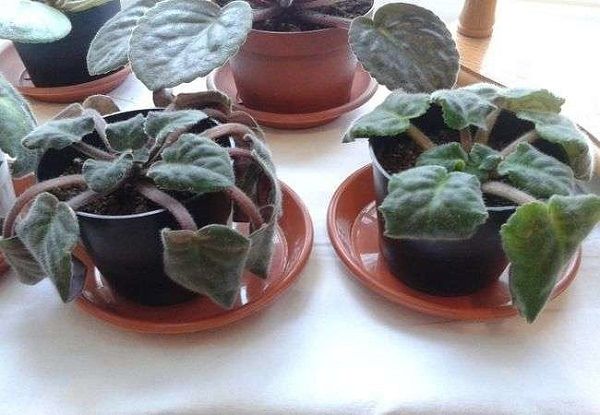

If the violet withers after transplanting, check the correctness of your actions.
Also wilting can begin due to improper care. If the reanimated plant is overmoistened, then even if this was not the problem initially, the excess moisture will play a negative role in the treatment.
Attention! Having determined why the violet withers and how to save it, you should immediately start resuscitation actions!
Diseases
This option is much more dangerous, since it can be quite difficult to recognize the disease. However, in most cases it is still possible to save the flower, but for this it is necessary to correctly diagnose and, of course, isolate the plant from other green pets. Most often, violets get sick fusarium and late blight, they manifest themselves in the appearance of spots on the leaves, followed by their withering and dropping.
With late blight, the leaves become lethargic, loose and begin to lose their elasticity, in addition, rusty spots can be seen on the plates. It should be noted that this disease is successfully treated, first, you should cut off all damaged leaves and roots, transplant the plant into a new container with fresh soil and treat with fungicidal preparations, for example, Fitoverm is highly effective.
If a violet gets sick with fusarium, then the leaves turn brown and fall off, and the roots darken. Unfortunately, there is no need to cherish special hopes for the restoration of the flower - in most cases it dies.
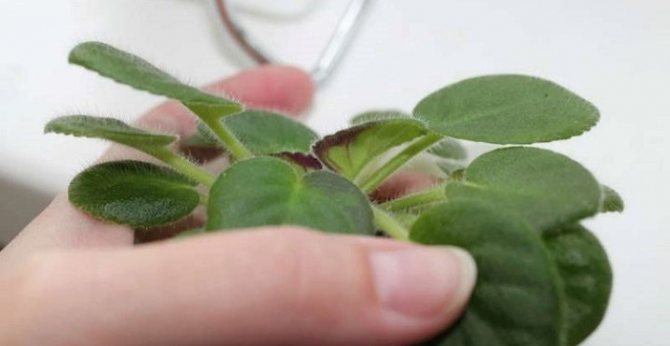

Can a dried flower be saved?
A very dangerous condition for violets is a lack of moisture. Dried violet is difficult to resuscitateif she's not completely gone, there is a chance.
In such situation it is important to identify the living parts of the plant:
- If drying started from the core, which happens extremely rarely, it is necessary to cut it off, then, with proper watering, stepchildren are formed;
- Dried up from the bottom the plant is transplanted, removing all damaged parts, if necessary, the top is re-rooted.
If you notice changes in the state of the flower in time and take action, it may not come to resuscitation. Sometimes the reason for the lack of the right amount of moisture is not forgetfulness, but planting in a new pot, applying a new type of watering or other changes in care, in which the owner does not even notice that the plant is not receiving moisture.
Features of violets
In nature, the violet grows on poor, loose soil. in the shade of tall trees, in conditions of long daylight hours. This must be taken into account when growing it in an apartment. Lush flowering indoor flower pleases only those who reckon with her natural habits.
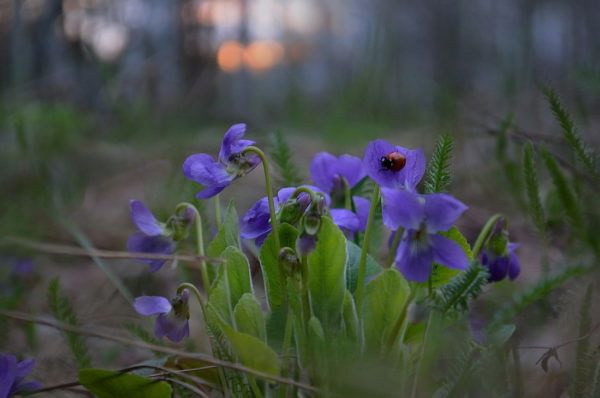

Violets grow naturally in the shade of trees.
As the violets grow, the lower leaves gradually:
- Turn yellow;
- And fade.
To maintain the decorativeness of the plant, their need to be removed periodically... But in some cases, the process of wilting leaves gets out of control and involves the whole plant. In this case, it is important:
- Establish the correct reason;
- And try to save the plant.
Use of succinic acid
Succinic acid in floriculture is used for plant nutrition and their rehabilitation after diseases. For violets in the process of resuscitation, this top dressing is also applicable.


Succinic acid is used to resuscitate violets.
Succinic acid stimulates the formation of new roots, the improvement of the condition of the leaves, the general health of the flower... Succinic acid is diluted in water according to the manufacturer's instructions and watering is carried out or the necessary part is simply rooted in this solution.
The reasons
The main reasons for the wilting of leaves in violets are:
- Diseases - this mainly concerns those diseases caused by fungi. In this case, microorganisms could penetrate into the plant body through the soil during transplantation or through microcracks that arose when a leaf or rhizome was accidentally damaged.
- Pests are mites or insects. As a rule, such parasites feed on plant juices and, as a result, deprive them of energy and strength.
- Improper care - abundant watering, root burns that were caused by the introduction of a large portion of certain fertilizers, a disturbed or initially incorrectly set temperature regime.
And before starting any treatment, you need to find out exactly what happened. Otherwise, all measures may be ineffective and the plant will die.
Important! In no case should you let go of the situation, thinking that the problem will go away on its own. The process may go too far and the consequences will be irreversible!
Pest and disease control
Traditional methods of combating diseases are effective in the initial stages. If the flower is seriously damaged, then fungicides should be used.
With root rot, cut off all diseased areas of the root to healthy tissue (it has a purple tint). If the entire root is damaged, the violet must be destroyed. If healthy tissue remains, cut off the lower flowers, treat the cut with a fungicide or potassium permanganate solution and place in water or wet to form healthy roots.
From pests, you can wipe the leaves with a soapy or alcohol solution. If it does not help, only chemicals will save Aktara, Karbofos.
Prophylaxis
For preventive purposes, in order to protect the violet from diseases and pests, it is necessary to follow these actions:
- when buying a new flower, do not put it right next to existing flowers, keep it in quarantine for a month in an individual place to avoid diseases;
- when buying a blooming violet, it is better to remove the inflorescences, this will reduce the chance of infection with thrips;
- before planting or transplanting, it is necessary to disinfect the soil and the pot;
- keep the plant at the correct temperature, and ensure that it is watered and fertilized on time in the correct proportions;
- inspect the flower monthly for the presence of parasites, if they are found, treat it with fungicides or insecticides.
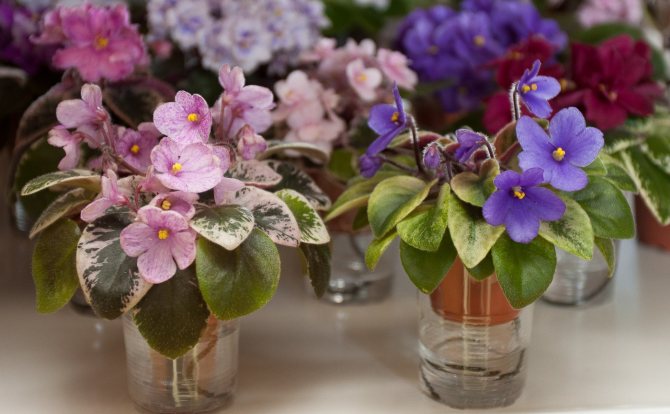

What a violet does not like
- Too much watering
- Strong dryness
- Uneven watering
- Cold, long-term content at ground temperatures below 16 ° C
- Heat, prolonged storage at temperatures over 27 ° C
- Direct sunlight
- Drafts
- Too high concentration of nitrogen in the soil, watering with manure infusion, excessive fertilization
- Alkaline soil with a high salt content
- Too high humidity and too low humidity
- Insect attack: thrips, scale insects. Ticks can only kill babies
- Heavy ground
If all of the above does not threaten violets, then they are very resistant to disease.
Is it possible to destroy pathogens by heat treatment of the soil or chemical preparations? Not. It is possible to destroy only pests by warming up: earthworms, some insect pests.
It is known that after some experiment, nematode larvae remained alive in the soil after two hours of cultivation at temperatures above 100 ° C.
Spores of fungi, bacteria survive even in space. Therefore, heat treatment only partially disinfects the substrate. But the structure of the soil is destroyed with prolonged heating. It is not necessary to process it for a long time, and no more than at 75 ° C.The most convenient way is in the microwave - as soon as the earth becomes hot to the touch, stop heating.
«>
Dry the earthen lump
To determine how serious the consequences of over-watering are, you can completely remove the flower from the pot:
- Place your palm on the ground, gently pinching the stem of the violet and the base between your fingers.
- Carefully turn the container upside down and, shaking the pot slightly, remove the soil with the seedling.
If the first time you failed to get the flower, return the container to its original position and separate the soil from the walls with a long knife, then turn the pot over again and try to remove the plant.
After completing the procedure, inspect the extracted earthen lump: if only the smell of dampness emanates from the substrate, without admixture of the "aroma" of rot, decomposition - to save the flooded violet, it will be enough to thoroughly dry the soil.
To do this, place the seedling soil on folded toilet paper, cotton cloth, or paper towel. Replace with new material as the litter gets wet. Drying the soil must be done within 24 hours, after which the violet can be returned to its original container.
Treatment methods
By changes in its appearance, the violet signals its poor condition. If the leaves begin to dry at the edges, then there is a non-observance of the rules for caring for these delicate flowers... To help the plant and prevent its death, it is necessary to take measures to improve agricultural technology as soon as possible:
- establish an irrigation regime. The frequency of watering should be selected depending on the season, room temperature and the individual characteristics of each plant. The problem with individual selection can be solved by using self-irrigated pots or transferring plants to wick irrigation;
- pour soft water. Hard tap water should be left to stand for at least 24 hours. Florists living outside the city can use rain or melt water for irrigation;
- monitor the humidity of the air. If necessary, humidify the air using possible methods;
- fertilize regularly. Depending on the season and growth phase, violets require different nutrients, macro and microelements. It is necessary to systematically feed or transplant plants into a new nutrient substrate.
Recovery from improper care
Violet leaves turn black, what should I do? After identifying the cause - care problems, it is important to exclude mistakespreviously admitted:
- When watering is a problem procedures and preventive actions are carried out:
- If necessary, the affected leaves are removed, usually, even after treatment, they gradually die off, and all this time they simply draw on themselves the strength and juices from the violet;
- If the soil is waterlogged, it is replaced, and the roots are given a day without additional watering. This is necessary to dry out and exclude possible root decay;
- For subsequent irrigation, only settled and warm water is used. it is also important not to overmoisten the transplanted plant.
- If the problem is in old or incorrect soil, it is replaced, and further adhere to the general rules of care. As in the first option, leaves affected by blackness are best removed;
- It is necessary to provide the right place and conditions... There should be a lot of light, but without direct sunlight. Temperature in the range of 16-25 °, and constant humidity. Moisture is provided with humidifiers or wet expanded clay under the pots;
- Ensure the correct dosage of nutrients... Top dressing is carried out every two weeks in the summer, and once a month in the winter. The concentration is made half as much as recommended in the instructions.
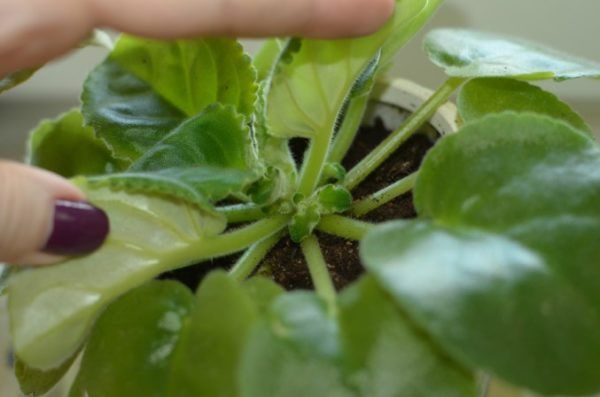

With proper care, violet leaves will feel great.
Advice! For any problem, it is advisable to remove damaged leaves, some growers recommend cutting off diseased areas and sprinkling with disinfectants.But this procedure usually ends with the gradual withering away of these plates. Therefore, if there are enough sheets left, it is better to remove all the blackened ones.
Why do the leaves wither?
If the leaves of a violet become soft and droop, the reason may be their natural aging and dying off. In this case, only the bottom 1-3 sheets are subject to changes.
Diseases affect the entire plant at once: the lower leaves wither, and the middle and upper leaves are twisted, their leaf blade decreases, the petioles are shortened, spots or plaque appear. The bush, which was blooming profusely before, stops flowering or forms too long or shortened arrows with a minimum number of buds.
Lack of light
Among the reasons why the violet withers is insufficient lighting. For good growth and abundant flowering, the plant needs about 12 hours of daylight. In winter, it is advisable to illuminate violets with phytolamps or daylight lamps.
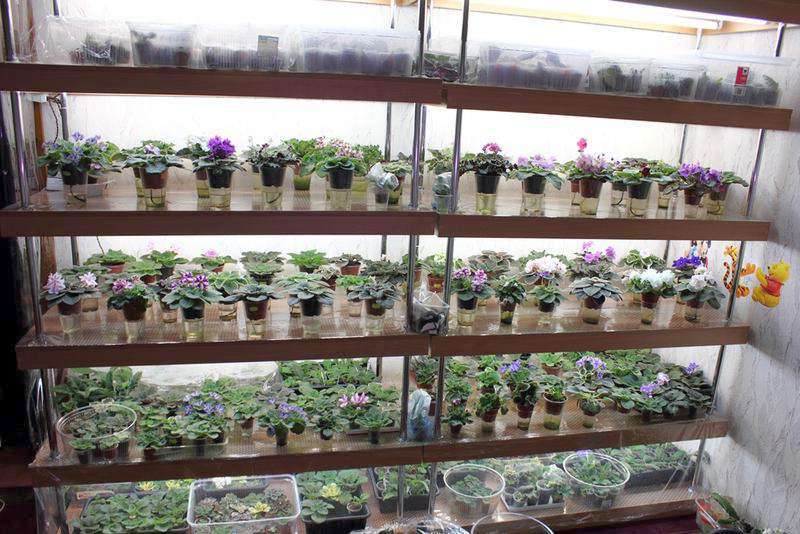

A sign of a lack of lighting is excessive lengthening of the petioles and peduncles. Sometimes they are more elongated on the side farthest from the window, and the flower looks skewed. With prolonged light deficiency, the leaves lose their color, become yellowish, and often begin to wither.
Improper watering
In combination with low temperatures and insufficient lighting, it becomes especially dangerous. Under unfavorable conditions, the flower goes into a state of dormancy, but it continues to be watered as abundantly as during active vegetation. Because of this, stagnation occurs in the soil and the violet withers, which prompts the owner to increase watering.
The result of such a mistake can be the death of Saintpaulia. When water stagnates in the soil, the roots of the flower begin to rot. An external sign of this is:
- sluggish leaves all over the plant;
- cessation of normal growth and development: leaves in the center of the rosette become small, with short petioles;
- cessation of flowering.
If you do not take measures to save the flower, it may die.
Symptoms of over-watering are similar to signs of a lack of moisture when a flower is overdried: in both cases, it lacks moisture and nutrients. Lack and excess of moisture are equally harmful to Saintpaulia. You can distinguish one condition from another by the moisture content of the soil.
Lack of fertilizer or satiety
With a lack or excess of minerals, the plant takes on a characteristic appearance:
- lack of nitrogenous compounds leads to pallor of the leaves, they lose their turgor and go down;
- excess nitrogen contributes to the formation of coarse dark leaf blades;
- deficiency of potassium and phosphorus causes the cessation of flowering: flowers and buds wither even on the formed arrows, and new ones are not formed;
- excess of these substances may resemble signs of a nitrogen deficiency.
A deficiency of trace elements (iron, sulfur, magnesium, etc.) often leads to discoloration of the leaf blades, curl and ugliness, crushing of leaves and flowers.
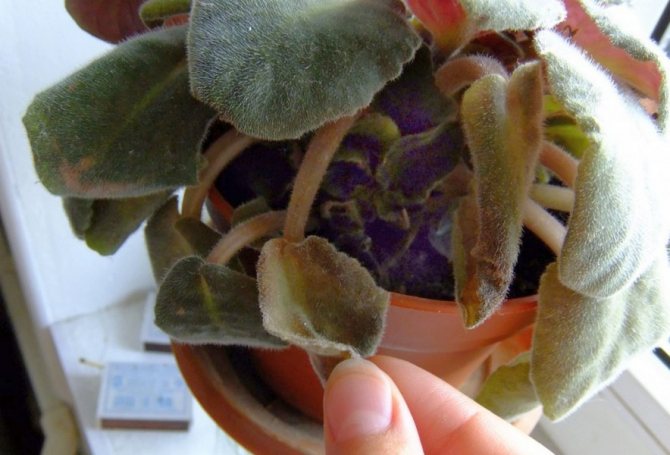

Unprepared soil
Sluggish leaves can be a sign of inadequate soil for the violet. The plant prefers sour, moisture-permeable, light earth, which contains many nutrients and retains moisture well. When purchasing a flower in a store, it is best to transplant it into soil for Saintpaulias at home. If it is impossible to buy a ready-made mixture, then a mixture of equal parts of leafy earth, peat and fine river sand would be a good substitute. From such a soil, the plant can easily obtain the necessary nutrients.


Influence of pests
A common reason why violet leaves become soft is due to insect damage. Among indoor pests, thrips become the most dangerous for violets. They can be found on the surface of the soil - they are small, white, mobile creatures.They are sucking pests and, with a large number, can lead to wilting of the plant.
If the air is too dry, violets are also damaged by spider mites. It is easier to find small pests and their webs on the underside of the leaves.
Fungal and bacterial microflora leads to the formation of spots and plaque of various types and colors. Sometimes the leaves become lethargic and acquire a translucent appearance, wateriness, and over time they begin to rot at the base. If signs of pests or diseases are found, urgent rescue measures must be taken (how to save a violet is described in a separate chapter).
Temperature and humidity
The range of temperatures acceptable for growing Saintpaulias is small. When it drops to + 15 ° C, the plant stops growing and stops blooming. The upper limit of the interval is + 25 ° С. In a too hot room, the plant loses its turgor and withers.
Sudden changes in temperature are undesirable. In the room where the uzambara violets grow, it is desirable to maintain a constant temperature at + 18 ... + 22 ° С. At the same time, the air humidity should be about 70%. To maintain it at a normal level, wide containers filled with water are placed near the containers with flowers.



